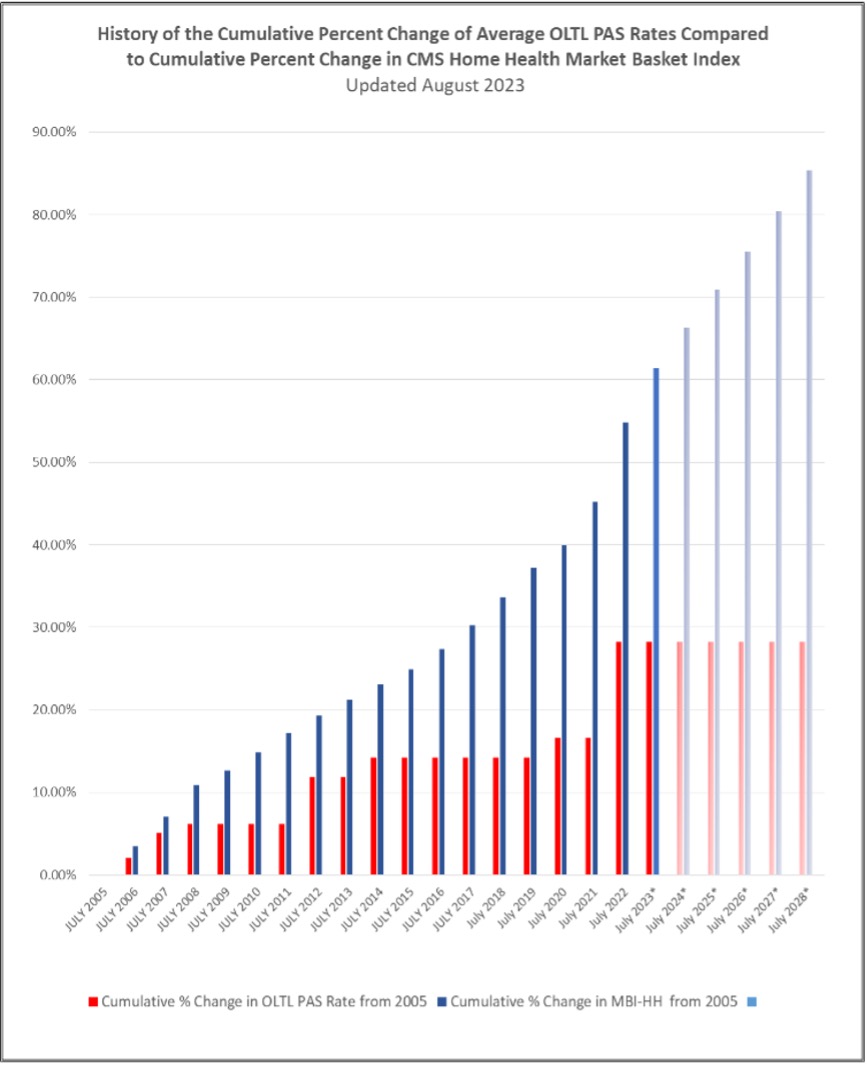Personal Assistance Services (PAS) are essential to people with disabilities, enabling Pennsylvanians with physical disabilities to live independently with dignity in their own homes and their own communities. Approximately 125,000 Pennsylvanians depend upon Personal Assistance Services every day[1] and this vulnerable population is expected to grow.
But independence is not supported in Pennsylvania.
Since 2005, the rates paid to providers has increased by 28%, yet the cost of delivering this service will have increased by 66%[2] by July 2024. We have fallen far behind.
This underfunding has caused a shortage of Direct Care Professionals in the OLTL PAS system, leading to people with disabilities not receiving the services they depend upon. We providers cannot provide a competitive and livable wage to attract and retain the necessary caregiver workforce.
Specifically, the American Network of Community Options and Resources (ANCOR) reports[3]:
- 95% of providers surveyed reported moderate or severe staffing shortages.
- More than three-fourths of respondents report turning away new referrals due to staffing shortages.
- 72% of respondents reported difficulties adhering to quality standards due to ongoing staffing challenges.
- Three-fourths of case managers report difficulties connecting people with services due to a lack of providers.

More People with Disabilities Will Need In Home PAS Care
The population of adults age 65 and older is estimated to increase from 56.1 million to 94.7 million, illustrating the increasing need for the care provided by Direct Care Professionals. But, in contrast, the population of adults 18 to 64 is expected to remain stable, meaning that there will be fewer potential caregivers to support older adults.[4]
But, from 2021 to 2031, the home care workforce is estimated to have nearly 5.5 million total job openings, including 924,000 jobs created by growth in demand, 2.3 million job openings caused by workers moving into other occupations, and 2.3 million due to workers leaving the labor force altogether.[5] There are not enough Direct Care Professionals to meet the need.
The Caregivers Need to be Supported
In 2022, the median annual earnings for in-home Direct Care Professionals nationwide are just $20,599. Median wages for home care Direct Care Professionals nationwide is $14.50 in 2022, after a decrease from 2021 to 2022 as pandemic-related funding was phased out. 42% of direct care workers live in low-income households (below 200% of the federal poverty level), with 15% living below the poverty level. More than half rely on public assistance, such as Medicaid, food and nutrition assistance, or cash assistance. The majority (85%) of direct care workers are women and the majority (66%) are people of color.[6]
Yet, without Direct Care Professionals providing hand-on care, in-home care does not exist and our older adults and people with disabilities cannot live independently. Direct Care Professionals are in-home care.
In-Home Personal Assistance Services has a History of Being Left Behind
Despite being less costly to Pennsylvanian taxpayers, at roughly one-half to one-third the cost of institutional placement, in-home PAS services have not kept up with the cost of providing high quality, reliable services. See the chart above.
Nursing homes, at double the cost of in-home PAS, received approximately a 20% rate increase in 2023 – yet in-home Personal Assistance Services and their Direct Care Professionals received 0%.
In 2023, managed care companies received an increase in funding of more than $928 million additional dollars over the 2022 budget – yet PAS providers and their Direct Care Professionals received 0%.
Solution
Community HealthChoices PAS providers are paid only about $21 an hour. This rate is not sufficient to offer competitive, attractive wages and benefits to Direct Care Professionals. Similar services under ODP are paid $32.32
In Home Care Personal Assistance Service in Pennsylvania NEEDS:
- An increase in our provider rates to $32.32 per hour to support livable wages and benefits for Direct Care Professionals and their support staff. This hourly rate is on par with the current DHS Office of Developmental Programs rate for Direct Support Professionals.
- A rate setting methodology and rate refresh schedule, similar to the Office of Developmental Programs.[7] The last OLTL Personal Assistance Service rate study that asked providers for their cost information was 2010 by Mercer Consulting. In the introduction, Mercer Consulting advised that additional comprehensive studies needed to be done regularly so that the service providers remain financially viable. However, such comprehensive studies have not occurred since. However, it is vital that a rate setting methodology and refresh schedule should be developed in close cooperation with the PAS providers, so that actual costs, not assumptions, are used.
- Ensure that the increase is paid to the PAS provider so that it can in turn benefit their Direct Care Professionals and support staff. This can be done by adjusting the published Medicaid fee schedule to $32.32.
YOUR voice is NEEDED to amplify the message.
You can do so easily here: www.votervoice.net/WannerAssoc/Campaigns/58916/Respond This link takes you to a webpage where you and adopt the proposed language or add your own message, and the website will send the message to your state legislators based on your home address. Your address is needed to determine who your state legislators are. Your email address is needed so that your legislator can reply to you, the voter. You can uncheck and opt out of “Send me email alerts” and “Remember me” if you wish.
1. Office of Long Term Living Data Dashboard, October 2023
2. CMS Home Healthcare Market Basket Index, retrieved August 2023
3. ANCOR The State of America’s Direct Support Workforce Crisis 2023
4. PHI Direct Care Workers in the United States Key Facts 2023
5. PHI Direct Care Workers in the United States Key Facts 2023
6. PHI Direct Care Workers in the United States Key Facts 2023
6. Pennsylvania ODP-Administered HCBS Proposed Rate Revisions Impact Analysis

